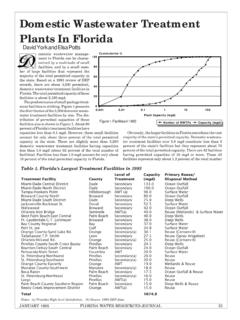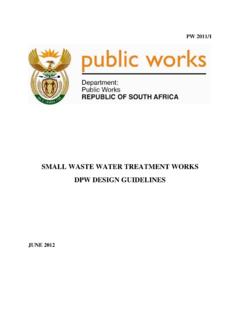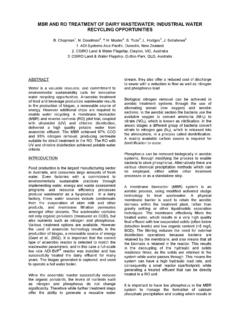Transcription of A quarterly publication of the Natural Gas …
1 Potter County, Pa. 1st Quarter 2018 Shale Gas Roundup A quarterly publication of the Natural Gas resource center Citizens have an opportunity to learn details about the shale gas wastewater treatment plant pro-posed for a parcel in west Coudersport and offer input to state regulators on Tuesday, Jan. 16, at the Gunzburger Building in Coudersport. Pa. Dept. of Environmental Protection (DEP) will host a presentation on the project at 5:30 A public hearing will follow at 7, during which testimony will be accepted by DEP. Epiphany Allegheny LLC of Pittsburgh is seeking to build the treatment facili-ty. Company officials say that treated water could be trucked away by tankers for reuse at drilling sites, or it could be processed through the borough s sew-age treatment plant. Epiphany said its plant could initially process about 20,000 gallons of fluid per day through a cellular water treatment system which uses distillation and mist evaporation. As additional gas wells are tapped in the region, that capacity could increase.
2 According to company officials, the process first removes minerals and heavy metals from the fluid. Solids are contained, dried and disposed of in state-licensed landfills. The brine that remains is processed in the second stage. Its by-products include distilled water, as well as salt that can be sold for com-mercial use such as road application. Numerous hurdles must be crossed be-fore the plan can proceed. Epiphany has applied for an operating permit from DEP. Meanwhile, Coudersport Area Munici-pal Authority (CAMA), which operates the sewage plant, must obtain a National Pollu-tant Discharge Elimination Systems (NPDES) permit. Study assesses industry impact on schools 2 Gas-fired electrical plant in Hebron Twp. 3 Counties form oil/gas advocacy organization 4 Gas production expected to rise in 2018 5 Inside this issue: Mike Broeker (left), chief operating officer for Epiphany Allegheny LLC, believes the company has come up with an environmentally friendly option for treating wastewater produced in shale gas drilling.
3 A high-tech membrane shown here by Carnegie-Mellon University professor Mea-gan Mauter allows water vapor to pass while blocking impurities. wastewater would be brought to the processing plant in tankers and either returned to well pads for further use, or processed through the borough s treatment facil-ity. Potter County, Pa. Page 2 Detailed study examines shale gas impact on schools Shale gas development in Pennsylvania has been the subject of public debate and academic research for more than a decade. But, until recently, no one was taking a look at the industry s impact on school dis-tricts. That has changed with the recent release of findings by the Penn State University Marcellus Edu-cation Team. A comprehensive survey of 940 educators as well as interviews and focus sessions with 50 educational and community leaders across Pennsylvania's shale gas range have been analyzed by the study s leaders, who reported their results late last year. Among their findings: --One-fourth of school districts have made curriculum adjust-ments in response to changing workforce needs, although many report having insufficient information and lack of coordination upon which to base these decisions.
4 --Despite uncertainty and a perceived lack of information, in-terviews with educational leaders in Pennsylvania's northern tier suggest that not only have shale gas-related workforce needs created new opportunities for young people exiting sec-ondary school, but that these opportunities have made career and technical center programming more attractive to students. --While school district respondents in areas with high drilling activity report significant local economic activity, they report that relatively little economic benefit has accrued back to schools. Respondents from some school districts, especially in areas with high drilling activity, are concerned that shale gas-related workforce demands may increase dropout rates. --Respondents in areas with high drilling activity have reported tightened housing markets, increases in housing rental costs, and increased residential insecurity and homelessness. Respond-ents report concerns about how this might affect recruitment and retention of staff when district salaries can neither keep pace with rising local costs, nor match gas industry-related sala-ries.
5 --School district respondents also report problems with road congestion, damage, and repair issues that affect school bus routes and schedules as well as public safety. --One of the most pressing questions shale gas development pos-es for schools is the extent to which gas industry jobs will be ac-Group calls for setback from schools Protect Our Children, a coalition of parents, concerned citizens, public health professionals and advocacy organizations, has delivered 3,000 petition signatures to the Pa. Dept. of Environmental Protection (DEP) calling for oil and gas activities to be kept at least one mile from schools. Members cite the potential health risks to students who are in close proximity to production facilities. Parents recognize that no amount of regulation will prevent accidents, said spokesman Crystal Yost. The only way to prevent exposure is simply to prevent this industrial ac-tivity from occurring near our schools in the first place. Nearly 150 schools and 170 day care centers in Pennsylvania are within one mile of well sites, according to one study, prompting the group s appeal to DEP.
6 Educators and school administrators across the shale gas-producing counties of Pennsylvania were interviewed in a Penn State study conducted to assess the industry s impact on public education. Shale Gas Roundup Page 3 Impact on schools (continued) This publication is produced by the Natural Gas resource center in Coudersport, Pennsylvania. Previous editions are available on the web-site, Anyone with story ideas or comments should contact Paul Heimel companied by influxes of new populations. If so, will this result in school enrollment changes and/or increas-es? Based on survey data, school personnel have reported relatively low impacts on enrollments. --About half of all school district respondents expressed doubt regarding the longevity of shale gas-related jobs. Respondents also expressed frustration over a relative lack of communication between school districts, career and technical centers. and the gas industry, and disagree-ment over the appropriate workforce development roles for each entity.
7 --While many educators see student preparation for post-secondary education as part of their mission, almost three-quarters of respondents believe that most jobs connected to the shale gas industry will not require a four-year college degree. This is consistent with a recent report suggesting that about three-quarters of the indus-try's direct workforce needs will require relatively little post-secondary education or trade certifications. This led some respondents to express concern about the possible effects on student educational aspirations and the transi-tion to college. School district administrators within Pennsylvania's shale gas region, like the communities they serve, need to be aware of and plan for the different phases of gas development, the study s authors concluded. There is a close interrelationship between community well-being and school well-being. Because of this interrelationship, schools are well placed to be active community partners with other community stakeholders in engaging in dis-cussion and debate about how shale gas development can be strategically managed for long-term and sustainable community development.
8 While rapid expansion of economic activity can have many positive effects for schools and communities, Pennsylvania's Natural gas is a finite resource . A pressing, and difficult, question is how the shorter term economic boom of shale gas development can be strategically man-aged so that Pennsylvania schools and communities can maximize their opportunities for long-term social, eco-nomic, and environmental sustainability. Turning shale gas into electricity Plans are in the works for a shale gas-fired electricity generating station in Potter County. Anchor Energy, a sub-sidiary of Pittsburgh-based IMG Mid-stream, is seeking an air quality per-mit from the Pa. Dept. of Environ-mental Protection for a facility in Hebron Township. IMG develops, owns and operates several small-scale generating stations, including four operating in gas-rich sections of Tioga and Bradford counties. The plant will be about the size of a basketball court and use local gas to generate approximately 20-22 mega-watts of electricity, which is enough to power 13,000 homes.
9 IMG spokes-person Kristi Gittins said the compa-ny does not expect construction to begin until 2019 at the earliest. "We haven't selected a specific site yet," she said. "We need about five or six acres and only one acre for the ac-tual building. Once we know more, we ll hold a community meeting to let everyone know the specifics." This electricity-generation plant is similar to what is being planned for Hebron Township in Potter County by Anchor Energy, tapping into shale gas in the region. Potter County, Pa. Page 4 Counties forming gas/oil advocacy organization Commissioners from many of the counties that are seeing a significant amount of shale gas activity are developing a coalition to promote energy development through statewide and national advocacy activities. The group has established a working title of Pennsylvania Council of Energy Producing Counties, and will be formalizing its operations in the coming months. Commissioners from the counties of Tioga, Bradford, Jefferson, Clearfield, Lycoming, Sullivan, Wyoming, Lawrence and Mercer attended the group s most recent meeting.
10 During a roundtable discussion, they agreed that the main focus of the council will be on gas and oil industry issues and opportunities. McClure Association Consultants has been retained to guide the council s development. Basic elements of its mission statement were agreed upon, including: Promote the energy industry in Pennsylvania. Promote an energy plan for Pennsylvania. Provide a voice for energy-producing counties and their residents on pre- and post-production matters. Provide advocacy services to energy producing counties on matters exclusive to ener-gy production. Create a forum to consistently monitor producer actions and marketplace develop-ments. Maintain a platform for tracking, monitoring, and mapping of energy production and production facilities. Offer meetings for energy-related educational programs and for networking. Shale Gas Roundup Page 5 Activity in Pennsylvania s gas fields slowed in recent years amid low prices, but operators ramped up drilling in 2017, and they re expecting to drill even more in the new year.











